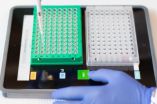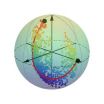(Press-News.org) CAMBRIDGE, Mass. (July 30, 2014) A team of Whitehead Institute researchers is bringing new levels of efficiency and accuracy to one of the most essential albeit tedious tasks of bench science: pipetting. And, in an effort to aid the scientific community at large, the group has established an open source system that enables anyone to benefit from this development free of charge.
Dubbed "iPipet," the system converts an iPad or any tablet computer into a "smart bench" that guides the execution of complex pipetting protocols. iPipet users can also share their pipetting designs with each other, distributing expertise across the research community. The system, created by researchers in the lab of Whitehead Fellow Yaniv Erlich, is described in detail in a letter appearing this week in the journal Nature Methods.
Erlich says that today's experiments frequently rely on high-throughput methods that combine large numbers of samples with large scale, complex pipetting designs. Pipetting errors can lead to experimental failure. Although liquid-handling robots would seem to be a logical choice for such work, they are also extremely expensive, difficult to program, and require trained personnel. Moreover, they can be plagued by technical snafus, ranging from bent or clogged tips to an inability to capture liquids lying close to the bottoms of individual wells.
"We needed an alternative to costly robots that would allow us to execute complex pipetting protocols," says Erlich. "This is especially important when working with human samples that are often in limited supply."
iPipet illuminates individual wells of standard 96- or 384-well plates placed on top of a tablet screen, guiding users through the transfer of samples or reagents from source to destination plates according to specific designs. Users create their own protocols in Microsoft Excel files in comma-separated format and upload them to the iPipet website, which generates a downloadable link for execution on a tablet computer. Included on the iPipet site are a variety demos and an instructional video.
So, how well does iPipet work? Beautifully, according to members of the Erlich lab. In a test of the tool against a liquid-handling robot, iPipet enabled nearly 3,000 fixed-volume pipetting steps in approximately seven hours. After significant time spent on calibration, the robot accomplished only half that number of steps in the same allotted time. To date, one of the only challenges lab users have encountered is keeping well plates in a fixed position on the tablet screen. For that, Erlich's team provides a solution: a 3D printed plastic adaptor that users can create with a file accessible via the iPipet website.
"The entire iPipet system is open source," says Erlich. "We want to maximize the benefit for the community and allow them to further develop this new man-machine interface for biological experiments"
INFORMATION:
This work was supported by a National Human Genome Research Institute (Grant R21HG006167).
Written by Matt Fearer
Yaniv Erlich is the Andria and Paul Heafy Fellow of Whitehead Institute for Biomedical Research, where his laboratory is located and all his research is conducted.
Full Citation:
"iPipet: sample handling using a tablet"
Nature Methods, July 30, 2014 (online)
Dina Zielinski (1), Assaf Gordon (1), Benjamin L. Zaks (2), Yaniv Erlich (1)
1. Whitehead Institute for Biomedical Research, Cambridge, MA 02142, USA.
2. Zaks Design, 20 Har Sinai, Ra'anana, Israel 43307.
Innovative scientists update old-school pipetting with new-age technology
2014-07-30
ELSE PRESS RELEASES FROM THIS DATE:
Mapping the optimal route between 2 quantum states
2014-07-30
As a quantum state collapses from a quantum superposition to a classical state or a different superposition, it will follow a path known as a quantum trajectory. For each start and end state there is an optimal or "most likely" path, but it is not as easy to predict the path or track it experimentally as a straight-line between two points would be in our everyday, classical world.
In a new paper featured this week on the cover of Nature, scientists from the University of Rochester, University of California at Berkeley and Washington University in St. Louis have shown ...
Young binary star system may form planets with weird and wild orbits
2014-07-30
Unlike our solitary Sun, most stars form in binary pairs -- two stars that orbit a common center of mass. Though remarkably plentiful, binaries pose a number of questions, including how and where planets form in such complex environments.
While surveying a series of binary stars with the Atacama Large Millimeter/submillimeter Array (ALMA), astronomers uncovered a striking pair of wildly misaligned planet-forming disks in the young binary star system HK Tau. These results provide the clearest picture ever of protoplanetary disks around a double star and could reveal important ...
Scientists reproduce evolutionary changes by manipulating embryonic development of mice
2014-07-30
A group of researchers from the University of Helsinki and the Universitat Autònoma de Barcelona have been able experimentally to reproduce in mice morphological changes which have taken millions of years to occur. Through small and gradual modifications in the embryonic development of mice teeth, induced in the laboratory, scientists have obtained teeth which morphologically are very similar to those observed in the fossil registry of rodent species which separated from mice millions of years ago.
To modify the development of their teeth, the team from the Institute ...
Conservation scientists asking wrong questions on climate change impacts on wildlife
2014-07-30
Scientists studying the potential effects of climate change on the world's animal and plant species are focusing on the wrong factors, according to a new paper by a research team from the Wildlife Conservation Society, University of Queensland, and other organizations. The authors claim that most of the conservation science is missing the point when it comes to climate change.
While the majority of climate change scientists focus on the "direct" threats of changing temperatures and precipitation after 2031, far fewer researchers are studying how short-term human adaptation ...
Antarctic ice sheet is result of CO2 decrease, not continental breakup
2014-07-30
DURHAM, N.H. – Climate modelers from the University of New Hampshire have shown that the most likely explanation for the initiation of Antarctic glaciation during a major climate shift 34 million years ago was decreased carbon dioxide (CO2) levels. The finding counters a 40-year-old theory suggesting massive rearrangements of Earth's continents caused global cooling and the abrupt formation of the Antarctic ice sheet. It will provide scientists insight into the climate change implications of current rising global CO2 levels.
In a paper published today in Nature, Matthew ...
NASA catches two tropical troublemakers in Northwestern Pacific: Halong and 96W
2014-07-30
There are two tropical low pressure areas in the Northwestern Pacific Ocean today and they're close enough to each other to be captured in one image generated from data gathered by NASA's Aqua satellite.
NASA's Aqua satellite flew over both Tropical Storm Halong and developing System 96W early on July 30 and the Atmospheric Infrared Sounder (AIRS) instrument captured infrared data on them in one image. Both systems show powerful thunderstorms stretching high into the troposphere with cloud top temperatures as cold as -63F/-52C. Those thunderstorms have the potential for ...
Watching Schrödinger's cat die (or come to life)
2014-07-30
One of the famous examples of the weirdness of quantum mechanics is the paradox of Schrödinger's cat.
If you put a cat inside an opaque box and make his life dependent on a random event, when does the cat die? When the random event occurs, or when you open the box?
Though common sense suggests the former, quantum mechanics – or at least the most common "Copenhagen" interpretation enunciated by Danish physicist Neils Bohr in the 1920s – says it's the latter. Someone has to observe the result before it becomes final. Until then, paradoxically, the cat is both dead and ...
Fear of losing money, not spending habits, affects investor risk tolerance, MU study finds
2014-07-30
As the U.S. economy slowly recovers, many investors remain wary about investing in the stock market. Investors' "risk tolerance," or their willingness to take risks, is an important factor for investors deciding whether, and how much, to invest in the stock market. Now, Michael Guillemette, an assistant professor of personal financial planning in the University of Missouri College of Human Environmental Sciences, along with David Nanigian, an associate professor at the American College, analyzed the causes of risk tolerance and found that loss aversion, or the fear of losing ...
When cooperation counts
2014-07-30
Everybody knows the shortest distance between two points is a straight line, and now Harvard researchers have evidence that sperm have been taking the familiar axiom to heart.
Though competition among individual sperm is usually thought to be intense, with each racing for the chance to fertilize the egg, Harvard scientists say in some species, sperm form cooperative groups that allow them to take a straighter path to potential fertilization.
A new study, conducted by Heidi Fisher, a post-doctoral student working in the lab of Hopi Hoekstra, Howard Hughes Investigator ...
Scientists call for new strategy in pursuit of HIV-free generation
2014-07-30
In light of the recent news that HIV has been detected in the Mississippi baby previously thought to have been cured of the disease, researchers are assessing how to help those born to HIV-infected mothers. These infants around the world are in need of new immune-based protective strategies, including vaccines delivered to mothers and babies and the means to boost potentially protective maternal antibodies, say researchers who write in the Cell Press journal Trends in Microbiology on July 30th.
"There is a real need for additional HIV-1 prevention methods for infants," ...




